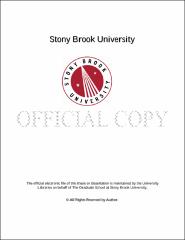| dc.identifier.uri | http://hdl.handle.net/11401/77414 | |
| dc.description.sponsorship | This work is sponsored by the Stony Brook University Graduate School in compliance with the requirements for completion of degree. | en_US |
| dc.format | Monograph | |
| dc.format.medium | Electronic Resource | en_US |
| dc.language.iso | en_US | |
| dc.publisher | The Graduate School, Stony Brook University: Stony Brook, NY. | |
| dc.type | Dissertation | |
| dcterms.abstract | My thesis analyzes two different topics: the estimation of the equity risk posed by the " too-big-to-fail" banks during the period encompassing The Great Recession; and a comparative analysis of the welfare effects of two different classes of affirmative action mechanisms. Both essays have been inspired by a desire to analyze currently enforced policies and to attempt to improve upon them by using arguments from Financial Econometrics and Game Theory respectively. The first essay is titled " The Empirical Foster-Hart Risk of the Global Banking Stock Market" and measures how much equity risk the too-big-to-fail banks posed on the common public during the recent financial crisis. In this essay I use an " ARMA(1,1)-GARCH(1,1)-Normal Tempered Stable" statistical model to capture the skewed and leptokurtotic nature of stock returns; and employ the " Foster-Hart risk measure" to better capture equity risk. This union of sophisticated risk modeling with fat-tailed statistical modeling bears fruit, as the paper is able to measure the equity risk during the Great Recession much more accurately than is possible with current techniques. The second essay is titled " Quotas versus Handicaps: A Game Theoretic Analysis of Affirmative Action Policies in India" . In this essay, I analyze and compare the Quota Policy -- in which preference is given to the disadvantaged section of the populace by reserving a certain fraction of jobs for them; and a hypothetical " Handicap Policy" -- in which the performance index of the disadvantaged is given an added boost, by means of an additive handicap. After modeling this situation as a game, I am able to conclude that on many important metrics of performance, Quotas and Handicaps can be shown to be equivalent to each other. | |
| dcterms.available | 2017-09-20T16:52:39Z | |
| dcterms.contributor | Dubey, Pradeep | en_US |
| dcterms.contributor | Brusco, Sandro | en_US |
| dcterms.contributor | Tauman, Yair | en_US |
| dcterms.contributor | Kim, Young. | en_US |
| dcterms.creator | Anand, Abhinav | |
| dcterms.dateAccepted | 2017-09-20T16:52:39Z | |
| dcterms.dateSubmitted | 2017-09-20T16:52:39Z | |
| dcterms.description | Department of Economics. | en_US |
| dcterms.extent | 77 pg. | en_US |
| dcterms.format | Monograph | |
| dcterms.format | Application/PDF | en_US |
| dcterms.identifier | http://hdl.handle.net/11401/77414 | |
| dcterms.issued | 2015-08-01 | |
| dcterms.language | en_US | |
| dcterms.provenance | Made available in DSpace on 2017-09-20T16:52:39Z (GMT). No. of bitstreams: 1
Anand_grad.sunysb_0771E_11991.pdf: 1244090 bytes, checksum: 76818b1d12b6914d28390d7c9f2eb7b8 (MD5)
Previous issue date: 2014 | en |
| dcterms.publisher | The Graduate School, Stony Brook University: Stony Brook, NY. | |
| dcterms.subject | Economics | |
| dcterms.title | Essays in Financial Econometrics and Game Theory | |
| dcterms.type | Dissertation | |

